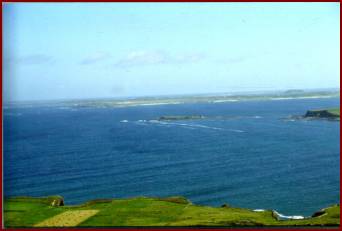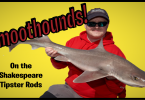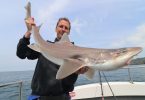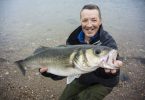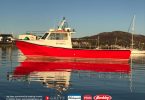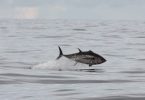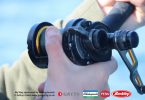Boat fishing on the drift has been a popular method of sea angling for years. Whether you are fishing for Plaice, Turbot or Brill along sandbanks, or for Cod and Pollack over a wreck, few anglers have experienced anything like the fishing available off the West Coast of Ireland.
How the hell do you go about setting yourself up for fishing uncharted territory?
What rod and reel do you use, what line, what rigs, what bait?
 These were the questions I found I was repeatedly asking myself throughout my last trip to Galway, Ireland.
These were the questions I found I was repeatedly asking myself throughout my last trip to Galway, Ireland.
It’s all so easy to travel to a well-known port and ask the skipper about local methods, but to delve into the unknown, not even knowing what the potential is, can be very unnerving.
I was lucky enough to have a good chat with the John Brittain, skipper of Blue Waters based at Clifden. He advised me that most of the marks in the area are very productive, and the potential for record-sized fish is very good indeed.
A lot of the area has no commercial pressure whatsoever, with only a few crab and lobster potters working throughout the year.
TACKLE
I was a bit apprehensive when John told me we would be drifting in nearly 500ft of water. The most you can expect in Britain is around 250ft, unless you venture to Scotland.
We steamed out about 5 miles to a deepwater drop-off, where John reckoned we were likely to encounter Cod, Pollack, Ling, Coalfish, Haddock and Dogfish, plus a few surprises.
He also said it was not impossible or unlikely for someone in the near future to hook a huge common skate or halibut in the area due to the depth of water. It seemed to me that the fishing there was almost, if not completely, untapped.
With this in mind I opted for a powerful 30lb class set up including a Penn 25GLS lever-drag multiplier.
The reason for this choice of reel was because it has a reliable clutch system, a moderately high retrieve ratio and it holds more than enough braided line for the sort of depths we would be fishing.
It is pointless opting for a slow retrieve reel in this depth, apart from anything else you would become tired very quickly, as those of you that have fished in depths of over 150ft with 2lb of lead will know.

LINES and LEADS
Mainline was the next choice I had to make. I started using braid as a mainline about four years ago, and am now convinced that in this sort of depth there really is no alternative for successful results. The instant bite registration that braid gives you, due to its lack of stretch, is vital when fishing at these depths.
33lb breaking strain Dynon 3000 was my choice, with 12ft of 40lb mono as a shock leader.
Shockleaders offer you two things, the first is to protect the business end of the braid from sharp rocks and other snags as the action of the boat drags your line and lead along the seabed. The second is to offer a slightly better chance of landing fish. It works much the same as an elastic band, giving the extra stretch needed if a fish near the surface suddenly decides that staying in the water is the best option and makes a sudden bid for freedom. Braid fished straight through would almost certainly pull the hook free or even snap if you were using a stiff rod.
If you use a shock leader, it absorbs the initial impact and stretch, allowing you a few vital seconds to react accordingly.
Perhaps the most interesting point about this particular trip was that even though we were fishing at extreme depth, we only needed 8oz of lead to get to get down effectively. I’m sure this would have been considerably more if I had been using monofilament.
RIGS
The beauty of fishing the unknown is that it lets you experiment with different tactics. In reality, anything would catch, but some rigs we used proved themselves to be better than others.
A 5ft long flowing trace made from 40lb mono and a size 5/0 hook worked well for me, while others on board preferred a set of baited Hokkais.
It is worth considering a heavy trace if you intend to fish with large baits, because you really don’t know what you are going to catch. Something like a 3ft, 100lb commercial mono hooklength with a size 6/0 O’Shaughnessy on the end is a good start, just in case there are a few skate or huge cod around.
As there isn’t much tide in the area and we were using braided line, we got away with using 8oz plain leads, whereas other marks may need you to use 2lb.
The important thing is to make sure you use the right amount of lead to keep your bait on the bottom, so you don’t have to let out too much line.
BAITS
Most of the angling in Ireland tends to be done with lures or fresh mackerel for bait.
There is usually an abundance of fresh mackerel available, but quality blast-frozen bait such as Ammo or Predator will catch just as well.
When using mackerel, use either a whole fillet, tail cone or head and guts for the best chances of catching.
Squid also works well, either on its own, in strips or bunched up the trace and when cocktailed with mackerel.
Every now and then you will come across a wreck, reef or patch of very rough ground. It is well worth taking a selection of lures with you such as pirks, artificial eels and jelly worms to use over these features. That way you could end up with a few nice cod, Pollack or ling.
PITFALLS
Unlike fishing in conventional depths, extreme depth sea angling poses certain problems you wouldn’t normally encounter. Perhaps the most obvious is that near enough everything you catch, bar a few dogfish, has to be kept.
A fish brought up from this depth will not go back because the swim bladder inflates, preventing it from sinking when thrown back. Obviously th
e undersized fish, which is a rare occurrence in Ireland, get thrown back in for the gulls. Extreme deep-sea angling is not for the conservation minded.
 A FEW SURPRISES
A FEW SURPRISES
After about one hour of drifting with only a few Dogfish, Pollack and Pouting to show for our efforts, I hooked into something that almost wrenched the rod from my hands. After just three minutes of playing the beast, or rather it playing me, my trace parted. It could have been a huge cod or Pollack, but I really have no idea what it was.
Shortly after this my dad boated a megrim, an unusual flatfish that is only ever found in deep water – or so I thought until I nearly broke the Channel Islands record last year in just 40ft!
It looks like a cross between a dab and a sole, but has an enormous mouth that it uses for sucking in small prey fish.
This was quite exciting, because no one on board had ever seen one before and it got us thinking about what else could be lurking in the depths.
CONTACTS
For more information of fishing the west-coast of Ireland give Leisure Angling a ring on – 01517 345586
To book a trip with John Brittain out of Clifden, give him a call on – 00353 9521073
Dave Barham

